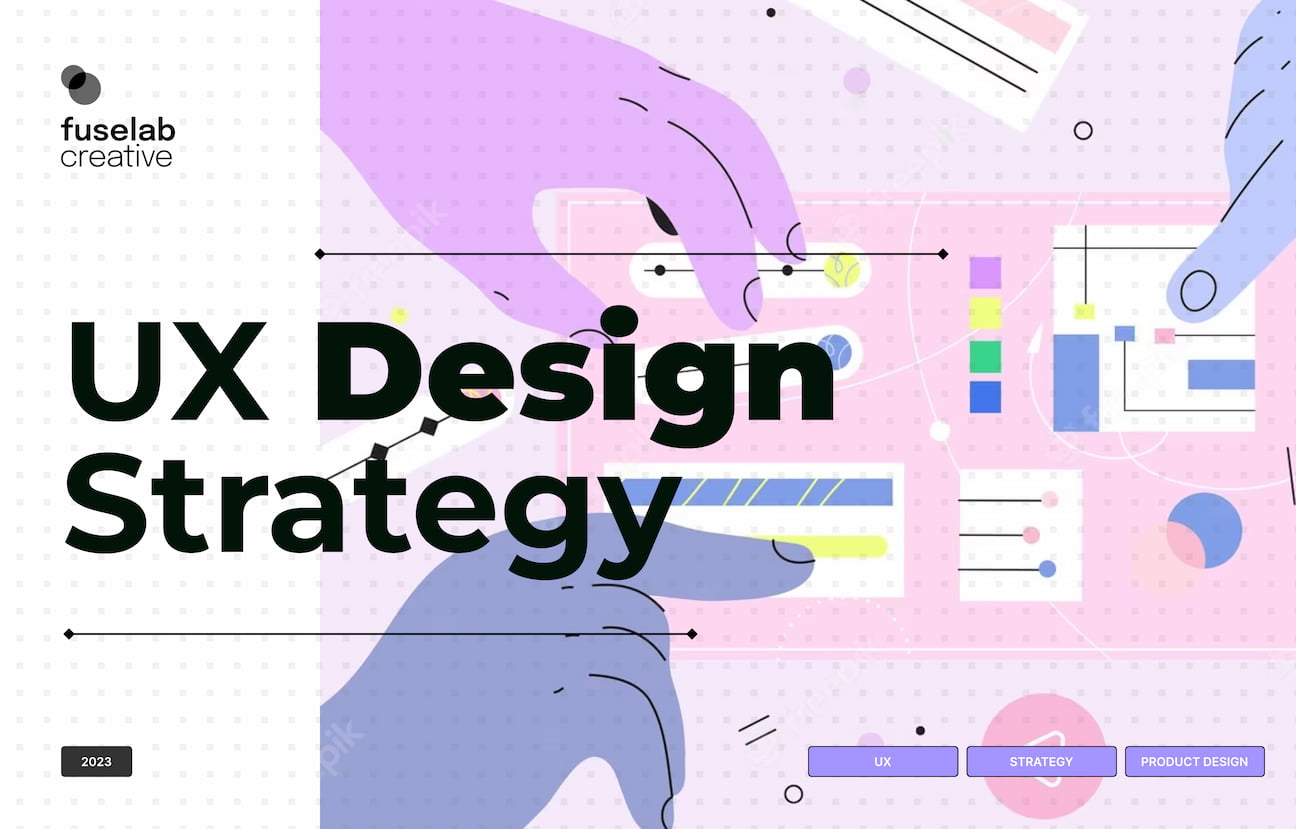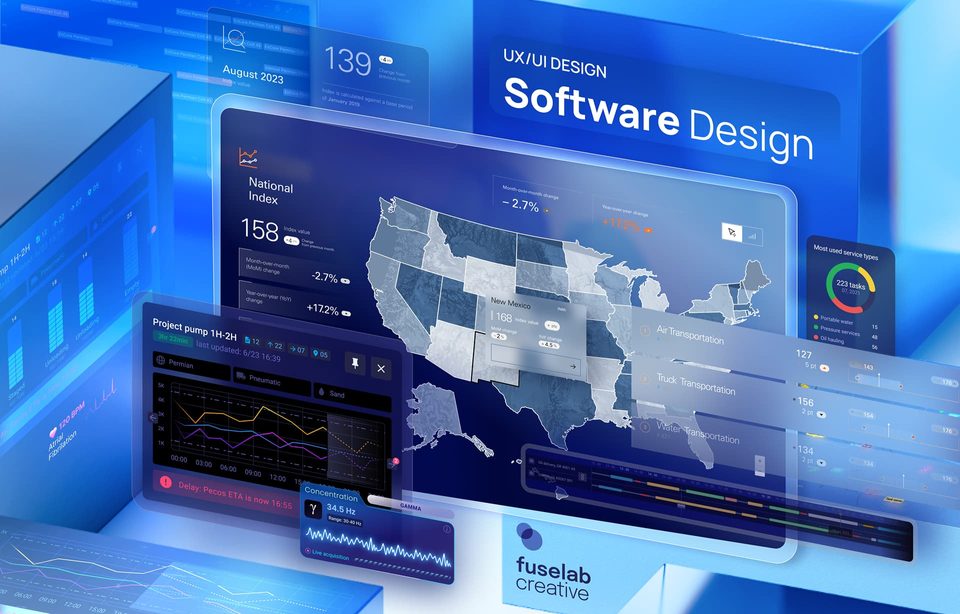Crafting A Winning UX Design Strategy: Your Ultimate Guide

A step-by-step plan to curate a user experience that understands, guides and compels your audience to take the next step to conversion.
The world of business is now more competitive than ever, and companies that fail to prioritize a user experience (UX) design strategy risk being left behind. Did you know that brands that invest in UX design strategy can see a return on investment (ROI) of up to 1000%? That’s right; a well-executed UX design strategy can increase conversion rates, reduce development time and costs, and improve customer satisfaction. However, despite the obvious benefits, many companies still fail to implement an effective plan or even realize they have one.
In today’s digital age, users have higher expectations than ever before when it comes to the usability and aesthetics of products and services. With well over 1.8 billion websites on the internet, it’s not enough to simply launch a website or app anymore. People expect a seamless, intuitive experience that provides value and solves their pain points.
So, let’s dig into UX and how to deploy an effective strategy.
What is UX Strategy?
You’ve probably heard of user experience (UX) design, but what about UX design strategy? It’s critical to designing compelling user experiences for any digital product or service. In simple terms, UX design strategy refers to the process of defining and aligning a product or service’s UX goals with the overall business objectives. It’s a kind of roadmap that outlines the steps and resources required to achieve these goals.
A successful user experience research and strategy requires a deep understanding of the target users and their needs, as well as the business objectives. Think of it as a comprehensive approach to design that takes into account the entire user journey, from initial discovery to post-purchase support.
How does it work?
Let’s take the user experience strategy example of Airbnb’s “Universal Design,” which was launched in 2015 to make the platform accessible to everyone, including those with disabilities. They partnered with the California State Independent Living Council and other organizations to develop a set of guidelines for hosts that would ensure accessibility and inclusivity for guests with disabilities.
The guidelines covered everything from accessible entryways to ensuring that hosts were knowledgeable about accessibility options in their area. Airbnb also created a filter for users to search for accessible listings and worked to raise awareness of accessibility issues among hosts and guests. By prioritizing Universal Design, Airbnb was able to create a more inclusive platform and reach a broader audience.
Moreover, a UX strategy can help firms build a user experience plan that satisfies corporate goals and user needs. So, you see how the UI UX strategy is leveraged. Now, let’s discover how it can benefit you.
Why UX Design Strategy Is Important?
Imagine you’re a customer visiting a website that’s difficult to navigate, with confusing instructions, unclear calls to action, and poor visual design. How likely are you to stick around and complete a purchase? The answer – is not very likely.
UX strategy deliverables are the tangible outputs produced during the design process that communicate the plan for achieving the desired user experience goals. In other words, without a UX strategy guide, companies risk losing customers, revenue, and market share. Hence, teams should establish clear metrics of success from the beginning to measure the UX design impact and ensure the product is on the right track. A well-designed plan, on the other hand, can provide a range of benefits, including:
- Improved Customer Satisfaction: By prioritizing the user experience, companies can build products that are intuitive, efficient, and easy to use. This leads to added customer satisfaction, which in turn can drive customer loyalty and brand advocacy. So, consider incorporating design thinking into your company’s strategy to potentially improve performance.
- Increased Conversion Rates: A thought-out UX can allow companies to streamline their sales funnel and make it easier for consumers to make a purchase. By creating a seamless user journey, you can increase conversion rates and drive revenue growth.
- Reduced Development Costs: Investing in UX design early in the product development process can help companies identify and solve issues before they become costly problems. Eventually, you may avoid expensive redesigns and changes down the line.
- Competitive Advantage: In today’s crowded marketplace, companies that prioritize UX design can gain an edge by providing a better overall customer experience. You can essentially attract and retain customers who recognize you as a leader in the industry.
Lastly, UX strategy consulting entails finding and executing design ideas that improve product or service user experience. So, develop a strategy to ensure alignment between business goals, user needs, and technological capabilities.

How to Create a UX Strategy: Process and Steps
Understanding UX strategy fundamentals is essential for creating successful user-centered design solutions. To create a UX design strategy tailored to your business goals and customers, you’ll need to follow a step-by-step UX strategy process. Here’s a high-level overview of what it looks like through the periscope of companies like Apple, Google, and Airbnb:
1. Define your business goals and user needs
Your UX content strategy should be driven by your business objectives and user needs. This involves conducting user research to understand your target audience’s goals, behaviors, and pain points. Hence, creating a solid UX strategy blueprint is essential for aligning stakeholders, outlining goals, and ensuring a successful user-centered design approach.
Airbnb’s UX design strategy toolkit is built around its business goal of creating a sense of belonging for travelers and hosts alike.
2. Define the scope of the project
Clearly defining the scope of your UX design project is essential to ensure that you stay focused on your goals and deliverables. Think of it as identifying the features and functionalities you want to include, as well as the timeline and budget.
Enterprise UX strategy requires cross-functional collaboration to ensure consistent user-centered design implementation across the organization. Also, keeping up with UI/UX design trends can help designers create interesting and eye-catching digital products for SaaS that satisfy modern user expectations.
Google’s goal for its search engine focuses on providing relevant search results within a fraction of a second.
3. Develop user personas
Developing a UX strategy entails identifying user needs and goals, establishing a clear vision for the user experience, and defining a roadmap of techniques to achieve those goals. For instance, using user research to create personas for an audience with very little time in their work schedule, such as medical providers, creates a specific goal for how a mobile app’s interface or tablet interface may support this sort of user.
User personas help you recognize your target audience by creating fictional characters that represent your user groups. Also, a UX audit evaluates an online item or service’s user experience and makes recommendations to improve usability, functionality, and user happiness.
Apple designs its iPhone’s UX by creating user personas based on factors such as age, gender, and lifestyle preferences.
4. Create user flows and wireframes
User flows, and wireframes help you visualize the user journey and the interface design. You can start with building low-fidelity wireframes and user flows and then test your ideas to gather feedback.
User-flows that enable travelers to find and book unique accommodations worldwide are Airbnb’s way of achieving their personalization in travel goal.
5. Develop a visual design language
A consistent visual design language helps you create a memorable user experience that aligns with your brand. A color palette, typography, and visual elements of UX strategy that convey your brand’s personality and values all form a part of this step.
Google’s UX design strategy incorporates a simple, minimalist visual design language that emphasizes clarity and ease of use.
6. Test and refine
The final step in the process involves testing your content strategy in UX design and refining it based on user feedback. This includes conducting usability tests, A/B testing, and user surveys to gather feedback and improve your design.
Apple’s iOS operating system employs regular testing of its new features and user interfaces to ensure that they meet evolving needs and preferences.
UI/UX Strategy
UI and UX design strategies are often thought of as separate entities, but they are inextricably linked. UI, or user interface, is the visual design and layout of a product, while UX, or user experience, is the overall involvement a user has while interacting with the product. You may successfully start evaluating where your product stands in the competitive landscape once you understand how to integrate your design for start-ups, or other types of engagements along with the existing corporate brand and strategy.
Creating a successful UI/UX design strategy requires aligning the design with the company’s business goals. This means considering factors like the company’s target audience, industry trends, and brand identity. Map out the user journey, identify pain points that need to be addressed, and apply the UI design changes that can be made to improve the overall user experience.
As an example, consider how Slack has aligned its UX and UI together. The messaging platform features a clean, simple design language optimized for productivity and collaboration. Consequently, the user experience turns out to be intuitive and easy to use, with features like customizable notifications and easy-to-use search sophisticated functionality.

Case Studies: User Experience Strategy Examples
How Dropbox Improved Its User Experience
One of the finest UX strategy examples is Dropbox. Dropbox is a cloud-based storage service for storing, sharing, and collaborating on files. In 2013, Dropbox redesigned its user interface to make it more intuitive and user-friendly. The overhaul included a cleaner and more streamlined interface, with fewer buttons and clearer calls-to-action.
One key feature of the new design was the introduction of a file preview feature. Previously, users had to download a file to view it, but with the new design, users can preview files directly in the browser. This reduced the number of steps for UX strategy to access and view files and made the experience much smoother and faster.
As a result of these changes, Dropbox saw a significant improvement in user engagement and satisfaction. Users reported that the new interface was easier to use and more intuitive, leading to increased productivity and fewer frustrations.
Like this, studying a successful UX design strategy example can provide valuable insights into the key components and best practices of user experience strategy development.
How Zillow Made Its Search Experience Work
Zillow is an online platform that allows users to search for homes and apartments. In 2020, Zillow reworked its search experience to help users find the properties that fit their individual goals.
The move saw a new map view that allowed users to view properties in their desired location, as well as filters that made it easier to refine search results based on specific criteria such as price, number of bedrooms, and amenities.
In addition to the new features, Zillow also focused on improving the speed and performance of the platform. As a result of the UX research strategy, Zillow saw a 25% increase in the number of people using the platform to search for homes. This led to increased revenue and market share, as well as improved customer loyalty and retention.
How Mailchimp Simplified Their Dashboard
As an email marketing platform, Mailchimp gives users the power to create and send email campaigns. In 2019, Mailchimp went for a better and bigger dashboard to make campaign management a breeze.
A new drag-and-drop editor that made it easier to create and edit emails, as well as a new reporting dashboard that provided more detailed insights into campaign performance, were taken to the users.
Mailchimp inadvertently saw a 20% increase in user engagement and a 15% increase in revenue. This called for increased customer loyalty, as well as an actual increment in brand recognition and reputation.
Measuring UX Strategy Success
Measuring the success of a user experience design strategy is crucial to understanding if it is working for your business. It’s not enough to create a design and hope for the best; it’s imperative to define clear goals and metrics from the outset and regularly review them to make adjustments as needed. Moreover, a UI/UX consulting agency can help businesses improve their digital products’ visual design and user experience.
One of the most prevalent metrics used to measure the success of a UX design is usability testing, which involves testing the design with real users to see how they interact with it. But other metrics can be just as valuable, including user engagement, conversion rates, task success rate, and Net Promoter Score.
- User Engagement: This is to understand if users are satisfied with your product or not. Start by looking at metrics such as time spent on your website or app, the number of pages visited, or the number of clicks made and correlate it with your design initiatives.
- Conversion Rates: Conversion rates account for the number of users who end up taking a desired action on your website or app. This could be making a purchase, filling out a form, or simply signing up for a newsletter. You can then determine if your UX design is helping users complete desired actions or if it needs to be improved. For example, revamping the eCommerce UX design of the booking process by simplifying it, and making it more visually appealing will make the purchasing process more user-friendly, which will no doubt increase the conversion rate.
- Task Success Rate: Task success rate reflects the percentage of users who can complete something on your website or app. The idea is to know how users lean towards the specific steps planned in the customer journey.
- Net Promoter Score: Net Promoter Score (NPS) is a metric that measures how likely users are to recommend your product to others. By measuring NPS, predict the users who are likely to promote your product and gauge brand loyalty.

Conclusion
With so much competition in the market, providing a user-centered experience has become a key differentiator that can change the formula for a company’s success. By investing in UX strategy, companies can improve customer satisfaction, loyalty, and retention, leading to increased revenue and growth.
Moreover, UX research and design can help companies identify the pain points, needs, and desires of their target audience. This data-driven approach informs digital product design, marketing, and UX business strategies, enabling companies to create solutions that better align with their business goals and user aspirations.
At the end of the day, you could be looking at reduced time and costs in product development and marketing while expanding your market share, in other words, everything you are currently working on every day!

Browse more

Data Visualization Trends 2024
